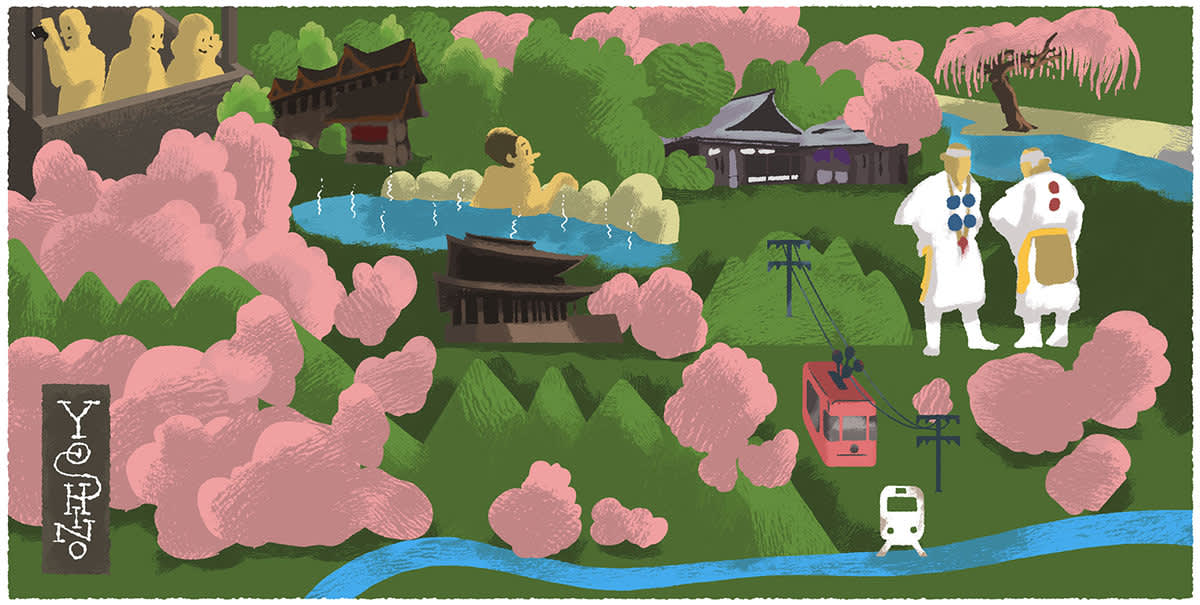A large area in southern Nara, Yoshino is best known for the mountain there of the same name. It is also renowned as a spring destination when over 30,000 cherry trees color the mountain and surrounding area pink. The best places to see cherry blossoms and bright autumn leaves are from Yoshimizu-jinja Shrine and Hanayagura Observatory, which offer sweeping vistas.
While Mt. Yoshino and Yoshinoyama town can become crowded in cherry blossom season, there are some quiet places to enjoy the blooms. Yoshino Mikumari-jinja Shrine, near the top of the mountain, has a beautiful garden with a weeping cherry tree.
While the whole mountain is nature’s garden, Chikurin-in Temple & Garden offers a man-made version of natural beauty, designed by the famous tea master Sen-no-Rikyu. Spring is an especially splendid time to visit, when the weeping cherry blossom trees are at their finest.
Experience Yoshino
Top Recommendations
Local Insights
Kuzumochi
These traditional Japanese sweets are formed from a mixture of kuzu, or Japanese arrowroot, and local spring water. Delicious accompanying green tea, the jelly-like dumplings are typically served with either a sweet, dark syrup, or kinako, toasted soy bean powder. Yoshino’s kuzumochi is renowned across Japan for its use of pure, local ingredients. Yoshinokuzu is a great place to try the dish when in Yoshino. Yoshinokuzu Yasokichi is a great place to try the dish when in Yoshino.
Kakinohazushi
Originating in the Yoshino area, this local form of sushi solved the problem of preserving fish on long journeys during the Edo era. Salmon and mackerel are lightly marinated in vinegar, placed on rice and wrapped in persimmon leaves, which help prevent bacterial growth. You will find kakinohazushi for sale all over Nara. The flavor’s unique, but give it a try! Learn more about Nara's unique cuisine.
Mt. Yoshino & Shugendo
In summer, you will see many male pilgrims in white robes in the Yoshinoyama area. They are Shugendo practitioners, who practice an ascetic form of spirituality, stressing physical endurance as a path to enlightenment. Local herbal medicines were developed hundreds of years ago to aid their journeys along the Omine-Okugake Trail.
Omine-Okugake Trail
This trail leads from the Yoshino and Omine mountains towards the Kumano Sanzan, a collection of sacred shrines in Wakayama. A difficult trail, it also serves as the training grounds for Shugendo practitioners. Although not recommended for inexperienced hikers, the parts around Yoshino are manageable. Read more about the Omine-Okugake Trail.
12 related lists & stories
Good to Know
Best Time to Go
One of Japan's top cherry blossom destinations, spring is an obvious choice for Yoshino. But equally impressive are the views of Mt. Yoshino colored in the reds and yellows of autumn. For a quieter, more intimate experience, a hot spring stay in winter is a good choice. Summer also sees fewer tourists than spring and offers the opportunity to glimpse Shugendo practitioners in the area.
Getting Around
The focal point of the Yoshino area is Mt. Yoshino. The mountain is served by a ropeway which runs from outside Yoshino Station: note that the ropeway does not operate on weekdays during winter. From the top ropeway station buses run between the major attractions. Service is irregular and suspended between February and March. Careful planning is necessary during winter.
Travel Tips
Unlike Nara City, rural Yoshino has few convenience stores and ATMs. Not all shops and hotels accept cards so you should take enough cash with you if planning an overnight stay. When traveling to see the cherry blossoms in spring, expect crowds and traffic. If planning a visit outside of the peak season, plan accordingly, as some facilities may operate irregular opening hours.
Other Tips
For avid hikers looking for a culturally-rich experience, the Omine-Okugake Trail, connecting Yoshino and Mt. Omine with spiritual sites in the south of Wakayama Prefecture, may be of interest. But before attempting the hike, it's important to understand that the trail serves as the training grounds for practitioners of Shugendo Buddhism. Certain parts around Mt. Omine are off-limits to women and the hike is a difficult one. A respectful mindset and thorough planning are essential.
Getting to Yoshino
The attractions around Mt. Yoshino and the town of Yoshinoyama are best explored from Yoshino Station. Unless you have a JR Rail Pass and are tied to using the JR Line, the most convenient route is from Kintetsu-Nara Station and takes a little over 90 minutes.


